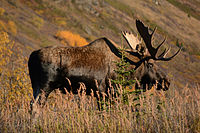
Photo from wikipedia
The bark-stripping behavior of Formosan sambar, Rusa unicolor swinhoii, has become conspicuous in recent years in the Tataka area of Yushan National Park in Taiwan and a cause for concern… Click to show full abstract
The bark-stripping behavior of Formosan sambar, Rusa unicolor swinhoii, has become conspicuous in recent years in the Tataka area of Yushan National Park in Taiwan and a cause for concern to visitors and ecologists. We conducted a monthly survey of 537 tagged trees of 21 species and monitored the abundance of sambar using camera traps from October 2018 to January 2021, aiming to interpret possible causes of the bark-stripping behavior in Tataka. We also used a generalized linear model to evaluate factors that may affect the probability of a tree having its bark stripped. Both our observations and the model predictions showed that sambar has a strong preference for bark of Pinus armandii, Photinia niitakayamensis, and Salix fulvopubeseens and for trees with diameter at breast height around 14 cm. Bark stripping mainly occurred between July and October when major forage was most abundant. However, sambar's need for bark surged in May when sambar abundance was moderate and decreased in October when sambar abundance was high. The seasonality of bark stripping was synchronized with the peak periods of antler development, fawn nursing, and spread of gastrointestinal parasites, suggesting that sambar strips bark to ingest minerals for their physiological needs and/or to acquire plant secondary metabolites to repel gastrointestinal parasites. Sambar abundance alone was not sufficient to predict the overall intensity of bark stripping. Rather, the product of sambar abundance and the necessity index (average wound size) were strongly correlated with the overall bark-stripping intensity. Therefore, controlling sambar abundance is essential but it alone may not be the optimal strategy for controlling bark stripping. A combination of population control and relaxing of sambar's parasite loading and/or physiological needs for minerals is an important strategy to control the overall bark stripping. Future research could use the necessity index to investigate the synchronicity of the bark-stripping behavior, deer's physiological state, environmental factors and phenology to better understand the cause of this behavior.
Journal Title: Zoological studies
Year Published: 2022
Link to full text (if available)
Share on Social Media: Sign Up to like & get
recommendations!